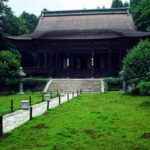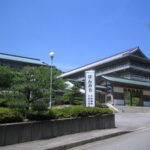There are five major religious traditions in Japan. They are:
Shinto, the belief that gods or spirits inhabit all our natural surroundings;
Buddhism, which teaches deliverance from suffering through the elimination of desire;
Taoism,respecting nature, while recognizing order and change in relation to opposing but connected forces;
Confucianism, emphasizing the family, education, social and political order and identity);
and folk religions, beliefs outside of organized religious practices, relating to everyday life.
While most Western religious devotees tend to practice one religion exclusively, most Japanese practitioners follow more than one of the above religious traditions, often at the same time. One example of this is the traditional practice of holding weddings in Shinto shrines, but funeral masses and other memorial services in Buddhist temples.
It may seem that the prevalence of so many different religious traditions in one place would lead to dissension and strife, but in actuality, and maybe paradoxically, the multiple religious traditions of Japan have had the tendency to unify rather than divide. Part of this has to do with the individual’s personal worldview, where a devotee might take certain parts from each religious tradition that he or she feels best applies to his or her own situation and will practice just those parts, making all religious practice more relative to the individual’s own worldview than to the particular discipline they follow. Another factor is the prevalence of six persistent themes in Japanese religion, namely the closeness of human beings, gods and nature; the religious character of the family; the significance of purification, specific rituals and amulets; the prominence of local festivals and individual cults; the pervasiveness of religion in everyday life; and the intimate bond between religion and the nation.
An ideal among Japanese religious practice is the harmony between mankind, the gods and the natural world, where the “gods” can be accounted for as being anything from the Shinto kami to the Buddhist bodhisattvas. This idea is unlike the Western idea of hierarchy, where there is often a direct line of authoritative control leading down from God to man to nature.
The religious character of the family in Japanese religious tradition includes both living and dead members of the family. Traditionally, the home was the center of religious practice, where the family head would serve as priest. Often the Japanese home houses a mini shrine, a type of family altar for daily prayers. The family is so central to religious tradition, and vice versa, that some consider the later structure of religious organization to be based on the model of the Japanese family.
Purification, rituals and amulets play a large part in the religious traditions of Japan. There are large containers of water in front of many Shinto shrines so that practitioners can wash their hands and rinse their mouths before approaching the shrines. Purification is seen as spiritual as well as physical, and Shinto, Buddhist and folk traditions all have purification rituals related to salt, water and fire. Rituals are more important in Japanese religious traditions than is the acceptance of doctrine, and there are many kinds of rituals for nearly all occasions, from blessings to exorcisms. Amulets are made of paper, wood, cloth, metal or plastic, and are hung in shrines as symbols for blessing and protection. They can also be verbal, recited as with scripture.
Unlike in the majority of Western religious traditions, there are no weekly services observed in Japanese traditions. However, this lack of regularly structured weekly observance is largely made up for by the observance of local religious festivals, which help unify the various religious traditions by being attended by large numbers of followers from varied traditional backgrounds. There are also those who follow individual deities, such as the Buddhist bodhisattva Jizo. Shrines and temples frequently get most of their visitors and financial compensation from these popular “cult” followers, who often meet in small groups dedicated to their one particular deity.
The previous four persistent religious themes in Japan speak to the pervasiveness of religion in everyday life in Japan. Devotees regularly visit shrines and temples. Babies are traditionally presented to guardian deities at Shinto shrines a month after they are born. Prayers are offered to various deities in the case of sickness or special need. Weddings, as noted above, are often held in Shinto shrines, while memorial services are held in Buddhist temples. There are even deities for sex and fertility, represented by carved stones.
Japanese religious tradition even pervades Japan as a nation. The emperor of Japan was traditionally considered a descendant of the Sun Goddess, and performed rituals on behalf of the nation for the benefit of its people. Buddhist principles supported the government, and the government in turn sanctioned Buddhism. The state even built temples for worship in every province. The government’s Bureau of Divination was set up to ensure that the ruler of the state would conform to the “way,” a basic principle in the religious tradition of Taoism. And the emperors themselves were thought to embody the social and ethical principles of Confucianism.
The many religious traditions of Japan may make it hard for Westerners, who are used to the exclusivity of one religion and the idea of the ultimate authority of one sovereign God, to understand how Japan isn’t in a constant state of social unrest and division. But when the many similarities among the persistent themes of the major Japanese religious traditions are taken into account, along with the idea of the Japanese acceptance of an individual’s right to a personal worldview, the unity of religious life in Japan is not so hard to comprehend.
Sources:
Earhart, H. Byron. Japanese Religion: Unity and Diversity. 4th ed. Belmont, CA: Thomson/Wadsworth, 2004.
Earhart, H. Byron. Religion in the Japanese Experience: Sources and Interpretations. 2nd ed. Belmont, CA: Wadsworth, 1997.



